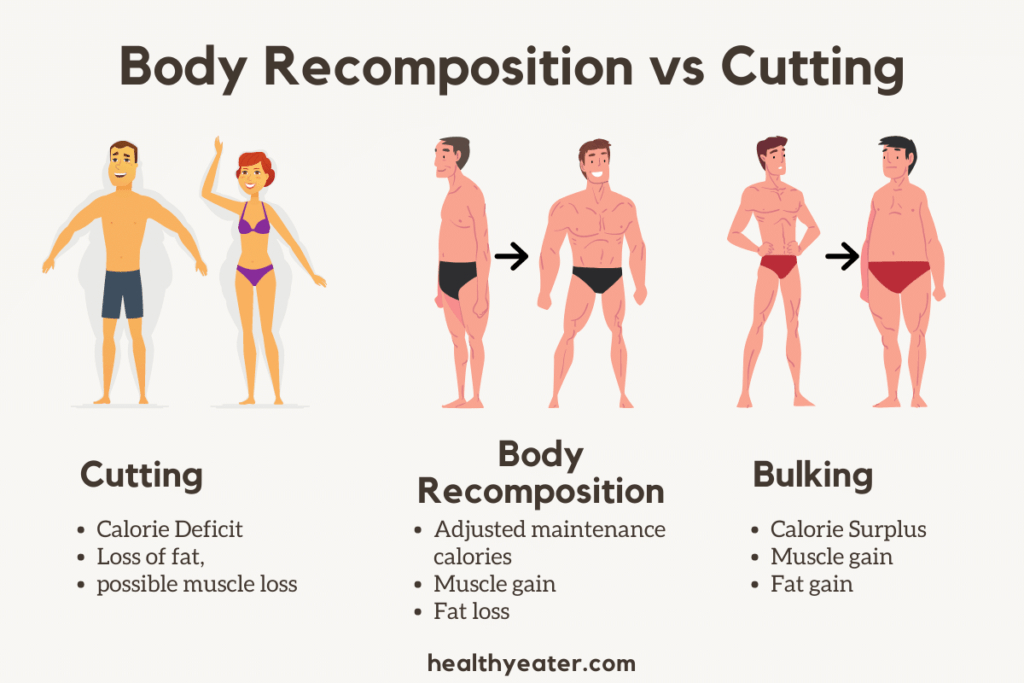Eating healthy while building muscle and burning fat feels challenging, yet it remains achievable. Moreover, proper training, nutrition, and recovery work together to optimize body recomposition. Consequently, you can gain lean muscle and reduce body fat simultaneously.

Scientific Principles of Body Recomposition
Body recomposition relies on balancing energy intake with expenditure while leveraging hormonal responses. First, you must create a slight calorie deficit to encourage fat loss without starving muscle growth. Next, you support muscle protein synthesis through quality nutrition and resistance training. Therefore, science underpins every strategy for building muscle and losing fat.
Hormonal Regulation
Hormones regulate muscle growth and fat storage in your body. First, testosterone and growth hormones drive muscle protein synthesis during workouts. Next, insulin helps transport nutrients into muscle cells while managing energy balance. Moreover, cortisol influences fat storage under stress, so managing stress remains crucial.
Energy Balance and Nutrient Partitioning
You balance energy by consuming slightly fewer calories than you burn while prioritizing high-quality nutrients. First, a moderate calorie deficit forces the body to utilize fat for fuel. Next, sufficient protein intake partitions nutrients toward muscle repair. Consequently, you achieve body recomposition through smart energy management.
Training Strategies for Body Recomposition
Effective training stimulates muscle growth and accelerates fat loss concurrently. First, resistance training builds muscle through progressive overload. Next, high-intensity interval training (HIIT) boosts metabolic rate and burns calories. Moreover, combining these methods ensures optimal results while keeping workouts efficient.
Resistance Training Fundamentals
Resistance training remains essential for stimulating muscle protein synthesis. First, focus on compound exercises like squats, deadlifts, and bench presses to work multiple muscle groups. Next, maintain proper form and gradually increase weights to challenge your muscles. Consequently, you foster continuous muscle growth and strength development.
High-Intensity Interval Training (HIIT)
HIIT enhances fat loss while preserving muscle mass through short bursts of intense exercise. First, alternate between high-intensity intervals and active recovery periods. Next, HIIT sessions increase your metabolic rate and improve cardiovascular fitness. Moreover, incorporating HIIT complements resistance training for rapid recomposition.
Nutritional Approaches for Muscle Gain and Fat Loss
Nutrition stands as the cornerstone of body recomposition, as it fuels workouts and recovery. First, you must consume a balanced diet rich in protein, complex carbohydrates, and healthy fats. Next, calorie management remains critical to create the right environment for both muscle growth and fat burning. Consequently, planning your meals supports long-term success.
Macronutrient Balance
A balanced diet includes essential macronutrients to optimize performance and recovery. First, high-quality protein sources like lean meats, legumes, and dairy support muscle repair. Next, complex carbohydrates supply steady energy throughout the day. Moreover, healthy fats from avocados, nuts, and olive oil regulate hormone production and improve satiety.
Meal Timing and Frequency
Meal timing plays a vital role in fueling workouts and recovery. First, eating a protein-rich meal before exercise boosts performance. Next, consuming balanced meals every three to four hours ensures constant nutrient supply. Additionally, post-workout nutrition accelerates muscle repair and replenishes energy stores.
Key Supplements for Recomposition
- Creatine improves strength and enhances muscle endurance during high-intensity workouts.
- Branched-Chain Amino Acids (BCAAs) promote muscle recovery and reduce soreness after training.
- Omega-3 fatty acids reduce inflammation and support overall cardiovascular health.
- Multivitamins and minerals fill potential nutritional gaps in your diet.
Recovery and Lifestyle Factors
Proper recovery remains critical for body recomposition. First, sleep enables muscle repair and hormonal balance. Next, stress management techniques help lower cortisol levels, promoting fat loss. Moreover, a consistent recovery plan supports sustained progress in your training regimen.

Sleep and Stress Management
Adequate sleep and low stress accelerate the recovery process and enhance hormonal function. First, aim for seven to nine hours of quality sleep per night. Next, practice stress-reduction techniques such as meditation, yoga, or deep breathing exercises. Consequently, these habits create a supportive environment for muscle growth and fat loss.
Advanced Techniques and Technologies
Emerging technologies help you monitor progress and optimize your training. First, wearable devices track heart rate, calorie burn, and sleep patterns accurately. Next, mobile apps offer nutrition tracking and workout planning features. Moreover, advanced gym equipment enables precise resistance training and performance measurement.
Case Studies and Success Stories
Many individuals have transformed their bodies using these recomposition principles. First, athletes often report dramatic improvements by combining resistance training with HIIT. Next, everyday people share success stories on fitness forums and social media. Moreover, these testimonials prove that a balanced approach works in real-life scenarios.
Practical Training Tips
- Warm up thoroughly to reduce injury risk before intense workouts.
- Incorporate both heavy lifting and bodyweight exercises for balanced strength gains.
- Vary your training routine every few weeks to prevent plateaus.
- Focus on compound movements to maximize workout efficiency and muscle engagement.
Monitoring Progress
Tracking progress ensures you stay motivated and adjust strategies as needed. First, measure your body composition regularly using scales or calipers. Next, take progress photos to visually assess changes over time. Moreover, monitor your strength improvements by recording workout performance consistently.
Strength is not just about lifting weights; it’s about lifting your habits, your discipline, and your mindset towards a healthier you.
Virat Kohli
Conclusion
Building muscle while losing fat at the same time demands a multifaceted, scientific approach. First, combine resistance training with HIIT to stimulate muscle growth and burn calories. Next, maintain a balanced diet with the right macronutrient ratios and strategic meal timing. Moreover, prioritize recovery through quality sleep and stress management techniques. Ultimately, these strategies allow you to achieve body recomposition effectively while supporting overall health and performance.
